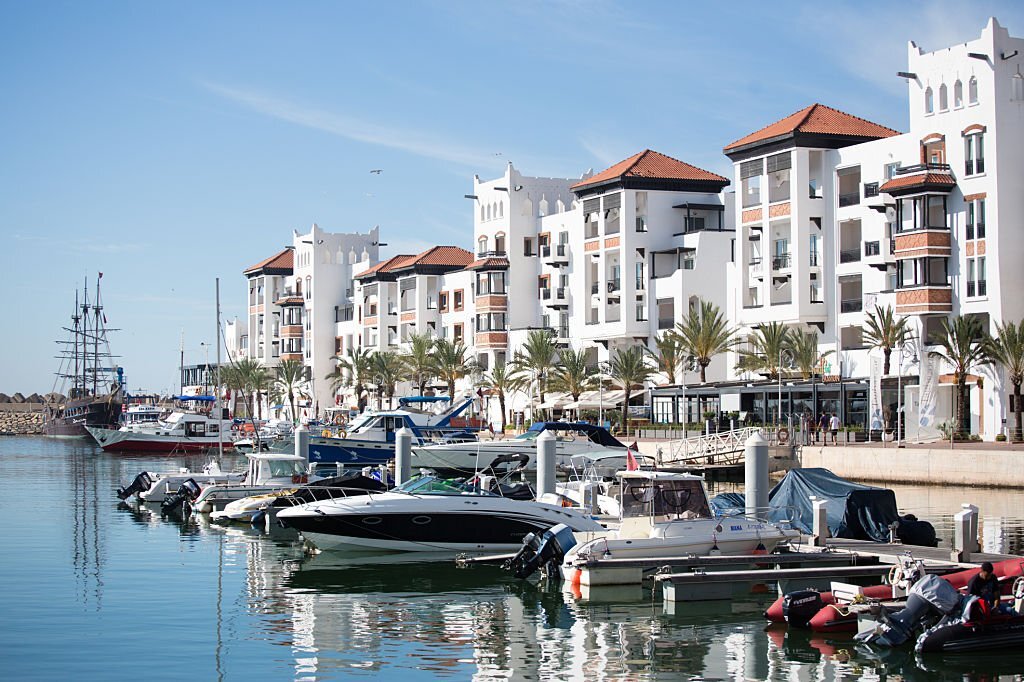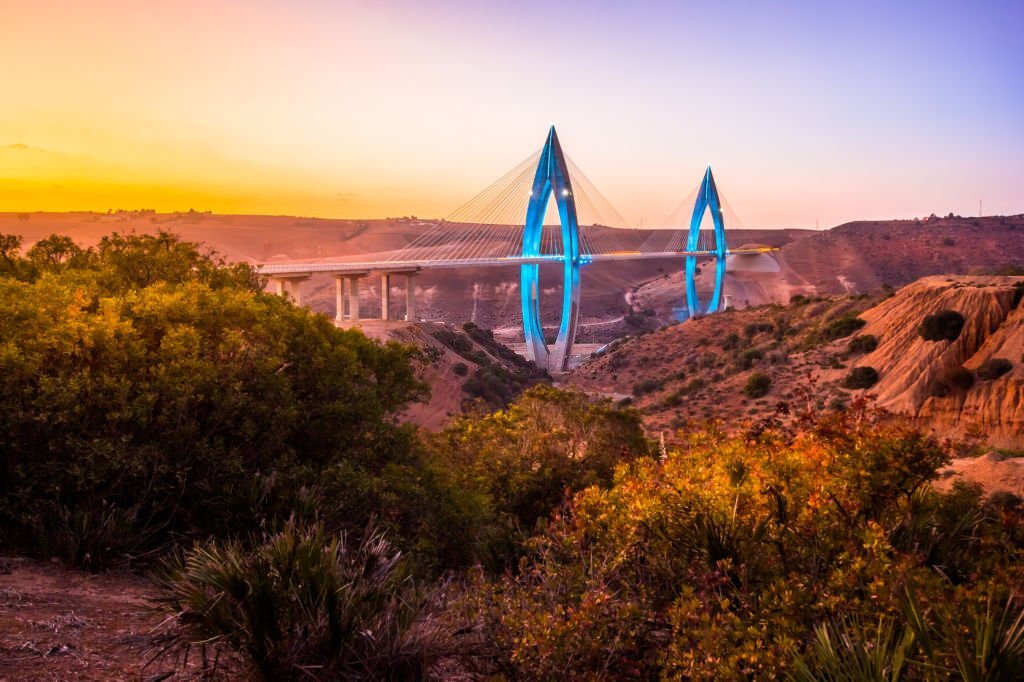Arrive in Casablanca. You will be picked up and transferred to the hotel. In the afternoon, visit the beach of Ain Diab. Food and drinks can be enjoyed along the long and gorgeous shoreline, which is lined with cafes, restaurants, and clubs. You can admire the beautiful sunset and the power of the ocean waves.
The Moroccan capital, Rabat, is located along the banks of the Bouregreg River and the Atlantic Ocean. It is recognized for its historical sites that reflect its Islamic and French colonial past, such as the Kasbah of the Udayas. This morning, you journey for approximately an hour down the coast to get there. This royal fort from the Berber era overlooks the coast and is encircled by formal gardens created by the French. Hassan Tower, Rabat's famous landmark, is the mosque's completed minaret. Both the mosque and the tower, both of which were started in 1195, had the goal of being the biggest in the world.
After visiting Rabat's attractions, we move on to Assilah, a town on Morocco's Atlantic coast south of Tangier. Portuguese colonial builders from the 15th century constructed well-preserved ramparts and gates to surround the city's ancient quarter, or medina. International d'Asilah art culture is celebrated annually in the Medina.
Today, you will travel through Tangiers and the Rif Mountains to get to Chefchaouen.
The seat of the Tangier-Tetouan-Al Hoceima area and the Tangier-Assilah prefecture of Morocco, Tangiers is a significant city in northwest Morocco, where the Mediterranean Sea meets the Atlantic Ocean off Cape Spartel.
Since prehistoric times, Berbers have lived in the Rif Mountains. In the 11th century BC, the Phoenicians established trading posts on the Mediterranean and Atlantic coasts, with the permission of the local Berbers, and began interbreeding, creating the punic language. They also founded cities like Tetouan, Melilla, Tangier, and Chefchaouen.
A city in northwest Morocco, Chefchaouen is also referred to as Chaouen. It serves as the capital of the same-named province and is distinguished for its blue-hued structures. Just inland from Tangier and Tetouan is Chefchaouen.
The largest town in Morocco's Rif area, Chefchaouen, is a great spot to escape the bustle of the imperial cities and have a relaxing day or two. The town, which the locals simply refer to as "Chaouen," is situated in northern Morocco and is renowned for its scenic medina, accessibility to the mountains, and an abundance of kif. Due to these features, Chefchaouen is a well-liked stop on the travel routes of backpackers, but many kinds of tourists visit the town to take in the architecture, discover Berber culture, and enjoy the natural surroundings.
You will explore the ancient Moroccan cities of Fez, Volubilis, and Meknes today as we depart from the blue city of Chefchaouen and travel to Fez via those cities.
Near Meknes in Morocco, Volubilis is a partially excavated Roman city that is widely regarded as the former capital of the Roman-Berber Kingdom of Mauretania. Built in a productive agricultural region, it began as a Phoenician-Carthaginian and Berber settlement in the third century BC before becoming the capital of the Berber Kingdom of Mauretania. It expanded quickly under Roman rule from the first century AD to the end of the third century, covering 100 acres and having a 2.6 km (1.6 mi) circuit of walls.
In the second century, the city added a number of significant public structures, such as a basilica, temple, and triumphal arch. Its success, which was mostly brought about by olive farming, led to the development of numerous elegant townhouses with spacious mosaic floors.
Meknes, one of Morocco's four imperial cities, is the sixth-largest city in terms of population and is where the Almoravids first established a military outpost in the 11th century. Sultan Moulay Ismail (1672–1727), the son of the Alaouite dynasty's founder, made Meknes the country's capital. The city of Meknes recorded a population of 632.079 in the 2014 Moroccan census; it is the seat of Meknes Prefecture and plays a significant economic role in the region of Fes-Meknes. Sultana Moulay Ismail transformed Meknes into an impressive city in Spanish-Moorish style, surrounded by high walls with great doors, where the harmonious blending of the Islamic and European styles of the 17th century Maghreb are still evident today.
A city guide will lead a day-long guided walking tour of Fez El-historic Bali's medina. Your tour guide will lead you through the confusing maze of souks and attractions, stopping at some of the highlights like the well-known Fes ceramic souk, the musical instrument and metalwork souks, the carpet souks, and the Tanneries Chaowara. More than 9000 medieval lanes with cobblestones wind through markets, mosques, Koranic schools, riads, and secret fountains. The Zaouia Moulay Idriss or shrine, the Bad Boujloud ornate gate, the Al-Kairaouine Mosque, the University—the oldest university in the world—Al-attain Medrasa, the Nejjarine Fountain, King's Place, and the Jewish neighborhood, or "Mellah," are all worthwhile stops. Your tour guide will make the most of your day.
Our journey from Fez to Erfoud, the fossil capital of the world, will take the entire day as we cross the Middle Atlas Mountains. As you leave Fez, the road progressively ascends through the breathtaking scenery you will see. Incredible panoramas of the Middle Atlas. The native Berber tribes of Morocco have a homeland here, and their culture and customs are still followed up here in the mountains. We pass through the Azro cedar trees along the way, with opportunities to pause and see the local Barbary apes. Our halfway point is the rural community of Midelt, known as the apple capital, and serves as a convenient lunch stop.
We will travel through the Ziz Valley and Gorges after crossing the Tizi N'Tairhemt Camel Pass and continuing over the Col du Zad. Finally, before reaching Erfoud, also known as the "gateway to the desert," we will pass the Meski Oasis on the verge of the vast Sahara. We will spend the night in our first fictitious kasbah, which is designed to resemble the ancient tribal strongholds of the Berber and Touareg people and offers comfort, breathtaking views, and is located on the edge of the desert.
We officially enter the Sahara today. After the lengthy drive yesterday, there isn't a lot of distance to travel (around 2 hours), so the morning is free for you to unwind at your hotel. After a leisurely lunch at your accommodation, we continue along the River Ziz via the Tafilalt Oasis and on to Rissani, the last sizable market town before the Saharan sands. Along the route, you can visit an archaeological museum and fascinating fossil workshops. You can alternatively take the Touristique circuit, which makes a detour through kasbahs, palm groves, and crumbling mud-brick cottages that indicate the location of the ancient ruin of Sijilmassa, formerly the richest city in North Africa and whose wealth was derived from trade caravans and gold.
You might also have time to stop by the Zaouia of Moulay Ali Shereef, a shrine outside of Rissani that is accessible to non-Muslims and features exquisitely sculpted plaster and mosaic interiors. By late afternoon, you arrive in the desert in Merzouga, a little community near the Erg Chebbi sand dunes. You have the option of spending the night in a standard or luxury class bivouac deep among the dunes, a kasbah-style hotel, a traditional riad/auberge, or even an eco-lodge made of mud close to the dunes. To fully experience the unique ambiance of the desert, watch the amazing star constellations, and witness the breathtaking sunrise over the sand dunes, we strongly advise camping there.
The final step of your journey is by camel if you choose to experience the peace of the dunes! The private tent in a desert camp during the night.
Breakfast is served in the desert camp early in the morning, and you return by camel to your vehicle afterward. We leave Merzouga Village and travel via the ochre cliffs of the Todra Gorges, Todra Valley, Dades Valley, and the Dades Gorges after spending the night under the desert stars. The Oasis of Tafilalet, the road, and the Valleys of Thousands of Kasbahs are all parts of our historic journey. With the high Atlas Mountains to the north and the Jbel Saghro range to the south, the Todra and Dades gorges provide us a peek of a new type of Moroccan scenery that is no less stunning but totally dissimilar from what we have seen on previous days.
We will have time to wander under the shade of the date palms and olive groves that border the riverbanks of the Rivers Todra and Dades, which provide water for a number of oasis and palmeraies in the area. Our day comes to a conclusion in the Dades Gorges, where we will spend the night in either a delightful guest house that clings to the sheer cliffs or an authentic converted kasbah in the Dades Valley with first-rate amenities and rooms decorated in an African motif.
We travel from the Dades Valley to the well-known Roses Valley and Kalaat Magouna town, where Morocco's primary rose and rose water industry is located. On the route, we will take an off-road detour to visit the BouTharar nomadic community, where the indigenous Ait Atta Berbers live in rock caves. Before concluding our day in Ouarzazate, dubbed "Hollywood of Africa," we will pass through the Skoura Village and Oasis, where we will visit the historic Kasbah Amredel and a small private museum. This mud-built home was constructed in the 17th century and once served as the Pasha el Glaoui's courthouse.
It is presently a first-rate boutique inn and a good illustration of conventional building techniques employing local resources.
Before we head out on the road once more in the morning, guests can take time for either a guided tour of the restored Atlas Film Studios. Our route takes us via the settlement of Tazenakht and into the desolate Anti-Atlas Mountains. After traveling for about two hours, we stop here for lunch. You can visit one of the cooperatives selling the hand-woven carpets that this area is known for. The journey continues for almost 4 hours through Taliouin, which is famous for its saffron farming, before arriving at the tiny walled city of Taroudant in the fertile Souss. Village Before the Saadian empire moved to Marrakech in the 16th century, Taroudant, also referred to as the "grandmother city of Marrakech," served as its capital.
This morning, you will take a leisurely guided tour of Taroudant's historic medina during which you will discover the city's history and stop by the two souks (referred to as the "Arab souk" and the "Berber souk," even though both cater to the needs of both clientele groups that reside in the area!) furthermore, tanneries Taroudant is a charming town that offers opportunity to observe local life in action and visit the souks without as much of the bustle as its "grand-daughter," "grandmother" Marrakech, while being considerably smaller and less spectacular. We are on the Souss River, whose fertile flood plains supply the entire region with fresh produce.
Many of the crafts you'll see being done at the souks aren't made to sell as souvenirs to tourists, but rather to local farmers as tools and agricultural equipment. You are free to explore and unwind on your own in the afternoon.
As we travel north along the rocky Atlantic coastline from Taroudant city to the port city of Essaouira, we pass via Agadir, Morocco's main beach resort. You will pass by sunbathers, surfers, fishermen, and some of the best bananas Morocco has to offer while traveling. You will witness both populated beaches with Moroccan families and desolate beaches if you travel during the summer. Argan oil, known as "Berber gold," is produced by women's cooperatives that harvest this priceless oil from the argan nut kernels in these protected forests of prickly argan trees.
Discover the calm, laid-back atmosphere of Essaouira's medina, stop by galleries to see the regional arts and crafts, savor a fresh seafood meal while taking in the sea views from a beachfront café, or stroll through the harbor or along the beach. We can organize watersports, camel rides, quad biking, horseback riding, and hiking in the adjacent beaches and woods for those who are more physically active. If you let us know in advance, we can also set up a morning cooking lesson.
In the morning, we hit the road for our final journey, to the exotic and bustling ‘red city’ of Marrakech. This is the last of the four Moroccan Imperial cities that you will experience on this tour. The journey from Essaouira takes around 3 hours and once we have checked in to a traditional riad in the ancient Marrakech medina, you have a free afternoon to explore and unwind. We suggest you head to the main Place Jemaa El Fna to grab yourself some lunch in one of the café restaurants which have a great roof-terrace view over the daytime activities of the busy main square – acrobats, snake-charmers, musicians, juice-sellers and henna-artists. The rest of the afternoon you can shop for bargains in the world’s biggest covered market and you can choose from Marrakech’s many restaurants for an evening meal, or even try the fabulous array of fayre on the outdoor grills of the Place Jemaa el Fna at nighttime.
Morning tour of the Imperial City of Marrakech, popularly referred to as "the red city," for its illustrious pink-hued ramparts, for half a day. After picking you up from your hotel in the morning, our English-speaking city guide will lead you through the medieval medina's souks, introducing you to craftspeople, bakers, carpenters, spice merchants, and apothecaries while also taking you to famous sites like the Ben Youssef Medersa, the Bahia Palace, and the Koutoubia Mosque. At the well-known Place Jemaa el Fna square, your tour comes to a close. The rest of the day is at your leisure, although we recommend taking a horse-drawn carriage to Gelize's new town area so you can see the stunning Majorelle Garden, which was formerly Yves Saint Laurent's and was Jacques Majorelle's private residence.
We advise you to go back to the plaza for dinner one evening and try some of the local specialties, including grilled meats, fried fish, fried aubergines, boiling snails, Harira soup, spiced ginger tea, and boiled sheepshead. Even if you choose to eat somewhere else, the Place Jemaa el Fna experience at night is enthralling, with the smoke rising from the grills, the pounding rhythms of the street performers, and the call to prayer echoing from the mosques as the eager throng gather for this nightly "circus."
The journey departs from Marrakech. It takes 2.5 hours to travel to the waterfalls. This is a fantastic chance to leave the city and see the less-traveled areas of Morocco! We'll have the chance to explore the surrounding area as we go, traveling through numerous quaint Moroccan towns and rural villages. Our driver will explain you to the region when we arrive at the waterfalls so that you have the greatest possible experience. You can take a stroll along the waterfall cascades, unwind while gazing at the falls, pack a picnic lunch, or go to one of the many cafes and restaurants nearby. Observe the wild monkeys that live in the treetops! We return after an afternoon of relaxation and sleep at Marrakech.
You will be met by your driver to travel to Ouirgane, a tiny village set in a breathtaking valley with unique birds and breathtaking surroundings. Here, you will meet your guide, mules, and muleteers to begin the gradual ascent. If you'd rather, you can also choose to walk. Before arriving in a small Berber village at the foothills where you will eat a specially prepared tagine lunch in a traditional Berber house while being encircled by the magnificent Atlas Mountains, you will have to hike for a few hours. You can witness how everything operates in the self-sufficient community, which is a very unique experience. After lunch, you can return down a little road with views of a dam and some nearby villages by foot or by riding your mule. Go back to Marrakech in late afternoon.
Day off in Marrakech to explore the attractions and the medina, or perhaps ride in a carriage to the renowned Majorelle Gardens in the new town. You might like to participate in a cooking class, a hot air balloon ride, horseback riding, camel riding, quad biking, golf, or spa/hammam treatments on this day. A visit to the legendary LA Mamounia hotel to partake in tea in the gardens or a very special romantic meal is another option for capping off your Special Morocco Experience.
Take the journey back to Casablanca after leaving your hotel. This concludes your Grand Tour of Morocco.
Please note that this is an indicative itinerary and subject to change. GT TRAVEL will customize the exact itinerary based on your preferences and availability.
Do not hesitate to contact us. We will be more than happy to accompany you and advise you.



